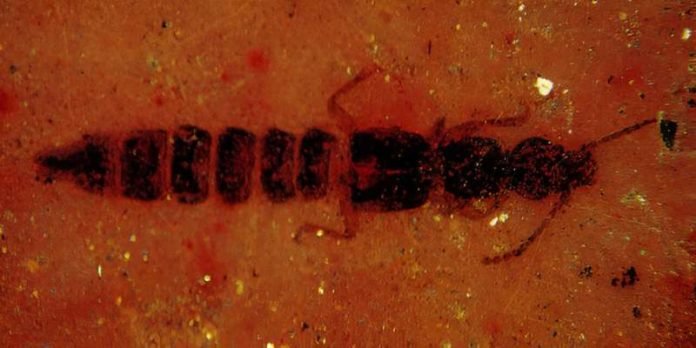
In the vast landscapes of Botswana, a remarkable discovery at the Orapa Diamond Mine has brought to light an ancient fossil that offers new insights into the history of beetles.
This fossil, belonging to the family of staphylinid rove beetles, dates back to the Cretaceous period, around 90 million years ago.
The research, detailed in the Journal of Entomological Science, introduces us to a previously unknown species, Paleothius mckayi, expanding our knowledge of these creatures’ ancient past.
The discovery of this beetle is significant for several reasons. Firstly, it represents the first fossil record of a staphylinine rove beetle in Africa, and indeed, in the Southern Hemisphere.
This find shifts the map of where we thought these beetles existed in ancient times, showing that they were not only present but also thrived alongside dinosaurs in areas far from where their fossils had been found before.
Paleothius mckayi was named in tribute to Dr. Ian James McKay, a distinguished paleoentomologist who played a crucial role in mentoring the lead researcher, Dr. Sandiso Mnguni.
This beetle’s remains, found in the sediments of what was once a crater lake, hint at a predatory lifestyle. Its long, sharp mouthparts likely played a role in hunting down prey within the dense leaf litter of its ancient habitat.
Rove beetles are known for their adaptability, capable of thriving in diverse environments from soil and leaf litter to the edges of water and animal nests.
The discovery of Paleothius mckayi adds to our understanding of how widespread these beetles were during the Cretaceous period, showcasing their ancient roots and enduring presence on our planet.
The preservation of this beetle, as a flattened imprint in sediment, is a rare glimpse into the world of Cretaceous beetles, which were as varied and widespread as their modern descendants.
Previous finds in countries like China, Russia, Myanmar, and England have shown us bits and pieces of their history, but the discovery in Botswana is a landmark in understanding the distribution and evolution of these insects.
This finding challenges our notions of evolutionary change, illustrating the concept of “punctuated evolution” – the idea that species can remain relatively unchanged for millions of years, punctuated by brief periods of rapid evolution.
The similarity between Paleothius mckayi and other beetle groups from even earlier periods suggests a long-standing familial connection, underscoring the slow pace at which some lineages evolve.
Describing a new species from fossil records involves meticulous examination and comparison of the specimen’s physical traits. This detailed work, often conducted under various types of light to reveal subtle features, is critical in distinguishing new species from known ones.
Dr. Mnguni’s work not only honors the legacy of his mentor but also sets the stage for future discoveries in the Orapa Diamond Mine.
With many more fossil rove beetles and other insect species waiting to be described, the mine’s deposits promise to further enrich our understanding of ancient ecosystems and the evolutionary history of insects on Earth.
This ongoing research continues to peel back the layers of time, revealing the intricate web of life that has spanned millions of years.
The research findings can be found in the Journal of Entomological Science.
Copyright © 2024 Knowridge Science Report. All rights reserved.



